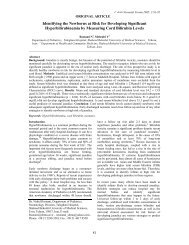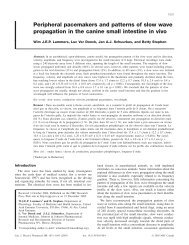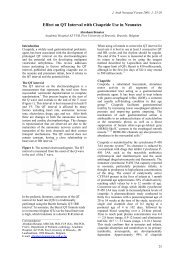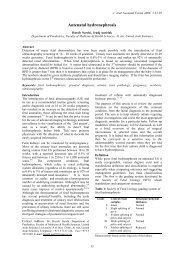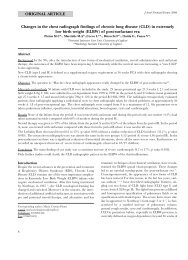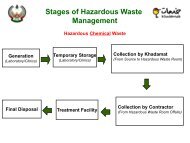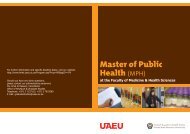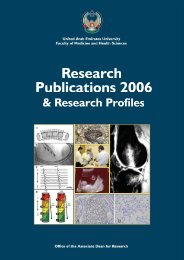Research Profile - College of Medicine and Health Science - United ...
Research Profile - College of Medicine and Health Science - United ...
Research Profile - College of Medicine and Health Science - United ...
Create successful ePaper yourself
Turn your PDF publications into a flip-book with our unique Google optimized e-Paper software.
Department <strong>of</strong> Pathology<br />
Histopathology/Lymphoma/Breast<br />
Pathology/CNS pathology/Renal Pathology/<br />
Molecular Pathology (Dr. Suhail Al-Salam)<br />
1. Expression <strong>of</strong> EBV in Hodgkin Lymphoma<br />
among UAE nationals<br />
The epidemiology <strong>of</strong> Hodgkin’s lymphoma (HL)<br />
shows wide geographic variation in histological<br />
subtypes <strong>and</strong> in its association with the Epstein-<br />
Barr virus (EBV). The proportion <strong>of</strong> EBV positive<br />
HL is low in industrialized countries, high in<br />
non-industrialized countries <strong>and</strong> intermediate<br />
in early-industrialized countries. Reports from<br />
the Arabian Gulf <strong>and</strong> Middle East are few. The<br />
aim <strong>of</strong> our study was to determine the<br />
epidemiology <strong>of</strong> HL in The population <strong>of</strong> <strong>United</strong><br />
Arab Emirates (UAE) nationals, an early<br />
industrialized country in the Arabian Gulf, <strong>and</strong><br />
to delineate the extent <strong>of</strong> its association with<br />
EBV. We review the cases <strong>of</strong> HL for the period<br />
1988 through 2004 for histological classification<br />
<strong>and</strong> demographic data. All Cases diagnosed as<br />
Hodgkin’s lymphoma were examined for the<br />
presence <strong>of</strong> EBV using immunohistochemistry<br />
(IHC) for the latent membrane protein I (LMPI)<br />
<strong>and</strong> in-situ hybridization (ISH) for EBV encoded<br />
RNA (EBER) to determine the prevalence <strong>of</strong> EBV<br />
in Hodgkin cells <strong>and</strong> its possible role in the<br />
Figure: (A) Hodgkin lymphoma with classical Reed–Sternberg cell showing dark-purple nuclear staining for EBER, in situ<br />
hybridization, X400. (B) Classical Reed–Sternberg cell showing membranous, cytoplasmic <strong>and</strong> Golgi immunoreactivity to LMP-1,<br />
streptavidin–biotin, X400<br />
56<br />
pathogenesis <strong>of</strong> Hodgkin’s lymphoma. EBV was<br />
seen in 17 <strong>of</strong> 45 (38%) cases <strong>of</strong> HL <strong>and</strong> was<br />
predominately seen in the MC subtype followed<br />
by NS, LD <strong>and</strong> LR subtypes, respectively.<br />
2. Types <strong>of</strong> mutations in BRCA 1 <strong>and</strong> BRCA 2<br />
genes in breast carcinoma among <strong>United</strong> Arab<br />
Emirates nationals <strong>and</strong> their correlation with<br />
P53, Ki 67, bcl2, nm2, c-erb-B2, estrogen receptors<br />
<strong>and</strong> progesterone receptors expression.<br />
Breast carcinoma is the most common<br />
malignant tumor <strong>and</strong> the leading cause <strong>of</strong><br />
cancer death in women all over the world. It is<br />
the commonest cancer among UAE population<br />
<strong>and</strong> the most common cancer among females<br />
The age specific incidence ratio for females in<br />
UAE was 19.4 per 100,000 population. It is<br />
currently estimated that 5–10% <strong>of</strong> all breast<br />
cancers are hereditary <strong>and</strong> attributable to<br />
mutations in several high penetrance<br />
susceptibility genes, <strong>of</strong> which only two have<br />
been identified BRCA1 <strong>and</strong> BRCA2. Earlier<br />
estimates suggested that BRCA1 <strong>and</strong> BRCA2<br />
mutations were responsible for 75% <strong>of</strong> sitespecific<br />
breast cancer families <strong>and</strong> the majority<br />
<strong>of</strong> breast <strong>and</strong> ovarian cancer families. The aim<br />
<strong>of</strong> this study is to identify the types <strong>of</strong> mutations<br />
in BRCA 1 <strong>and</strong> BRCA 2 genes in breast carcinoma




